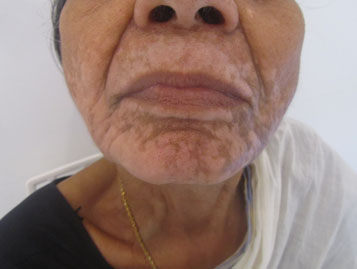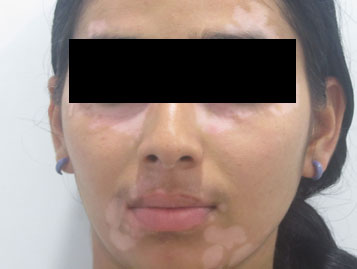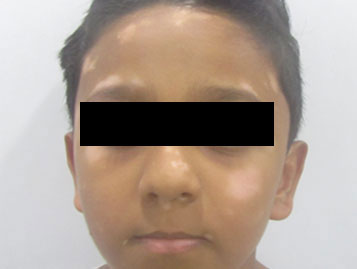Vitiligo
Vitiligo is a disease that causes the skin to lose its colour, resulting in pale white patches (5 mm or larger) or macules (less than 5 mm) that show up on the skin.
The lack of a pigment, called melanin, primarily causes it. It appears when melanocytes (skin pigment cells) are unable to function or when they die.
Vitiligo treatment before and after

After

After

After
As per studies, Vitiligo affects nearly 1%–2% of the world population irrespective of race and ethnicity, with the highest incidence recorded in the Indian subcontinent, followed by Mexico and Japan.
Vitiligo has a high prevalence among people in India and is more noticeable in people with darker skin. Loss of skin colour can affect any part of the body, including the mouth and eyes. But it commonly happens on the face, neck and hands, and skin creases. The hair on your body may also turn white if you have the disease in that place.

June 25 is observed as World Vitiligo Day, a day aimed to build awareness of the skin condition vitiligo.
What causes Vitiligo?
The precise cause behind Vitiligo is currently unknown. Still, research suggests that it may arise from an autoimmune condition where a person’s body destroys its melanocytes, resulting in noticeable white patches on the skin. In addition, stress, family history of Vitiligo, overexposure to the sun or viral causes also result in Vitiligo.
People affected can suffer from depression, anxiety, and social embarrassment. They can also feel very self-conscious due to their physical appearance.
Types of Vitiligo
Researchers have identified mainly two main categories of Vitiligo; segmental vitiligo (localised) and nonsegmental (generalised) vitiligo.
Generalised Vitiligo, which is the most common form, involves loss of pigment (depigmentation) in patches of skin all over the body. In generalised Vitiligo, there is usually symmetry in where the depigmentation patches occur. New patches can occur over time and can be over large body areas or in particular areas. And blotches typically occur on the face, neck, and scalp and around body openings such as the mouth and genitals.
And depigmentation is noticeable in areas of the body that tend to experience rubbing, impact, or other trauma, viz., hands, arms, and places where bones are close to the skin surface (bony prominences). Often pigment is lost in mucous membranes, such as the lips.
Localised Vitiligo tends to affect areas of the skin associated with dorsal roots from the spinal cord. Typically it manifests as one or more areas of pigment loss on only one side of the body. Smaller patches of depigmented skin on one side of the body in a limited area occur in about 10% of affected individuals.
Generalised Vitiligo can occur at any age, whereas localised Vitiligo is more likely to occur in the teenage years.
A survey conducted by WHO states that half of the people who have Vitiligo develop within 20 years and the rest of them before 40 years.
Although the focal pattern, segmental Vitiligo, remain localised and do not spread to the neighbouring area, general Vitiligo has no guarantee. It depends on the human tissues and skin nature.
This disease doesn’t spread; for some, it spreads so slowly over a year, and for some others, it just spreads like a fire.
Vitiligo treatment
Though there is currently no cure for the disease, there are treatments available. As a rule of thumb, the earlier you begin treatment, the better the results would be.
It is in no way a life-threatening condition; however, it can significantly impact the sufferer’s psychological and psychosocial well-being.
Various surgical methods are followed at our clinic to treat Vitiligo and other similar skin diseases. However, the treatment may improve the appearance of the skin but doesn’t cure the disease.
- Punch grafting
- Blister roof grafting
- Split thickness skin grafting
- Melanocyte transplantation
Melanocyte transplantation
The most advanced among these is melanocyte transplantation which gives excellent cosmetic results with minimum or no side effects. It is a safe and simple outpatient procedure and treats multiple areas simultaneously.
Melanocyte transplantation involves grafting the skin cells on the affected area (white patches). In this method, a thin layer of skin is taken from the normal skin (usually thighs), and the skin cells are separated and grafted onto the affected area. The cosmetic result with this treatment is better than other surgical options like skin grafting.
This technique’s advantages are that only a small area of skin is needed to cover large white patches, no scarring, good cosmesis, can be done as an outpatient procedure, & does not require general anaesthesia.
If you suffer from Vitiligo or know someone else who does, we highly recommend beginning the treatment.
